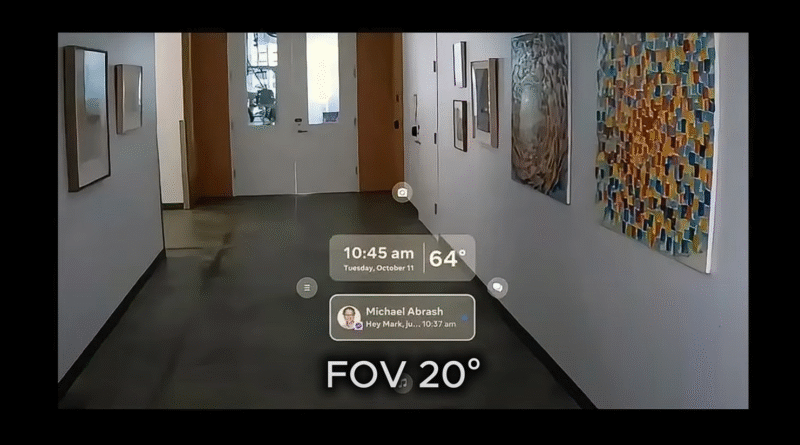Beyond the Leak: A Comprehensive Look at Meta’s “Celeste” Smart Glasses and the Future of Wearable Tech
In recent years, smart glasses have become a focal point of innovation and speculation within the tech community. Major players like Google, Apple, and Meta have all invested heavily in developing these next-generation wearable devices. Despite various launches, smart glasses have yet to gain widespread adoption, primarily due to limitations in design, functionality, and user experience. However, whispers about Meta’s upcoming “Celeste” smart glasses suggest a possible turning point. According to recent leaks, these glasses will feature an integrated display and a wrist-worn controller, potentially offering users an unprecedented level of interaction and immersion. For VR and AR enthusiasts following these developments closely, we at vrgamenews.com take a deep dive into what this could mean for the future of wearable tech.
What Do the Leaks Reveal About “Celeste”?
The most notable information about Meta’s “Celeste” smart glasses emerged from recent leaks that have set the tech community abuzz. Reports suggest that the device will incorporate a built-in display directly into the lenses, accompanied by an innovative wrist-worn controller to interact with the device. But what exactly does this imply?
Integrated Display: A New Perspective on Information Access
Until now, most smart glasses on the market have primarily relied on external cameras, microphones, and speakers, aiming to gather environmental data and provide audio feedback. These devices often lacked a truly immersive visual experience, with limited or no displays integrated into the lenses themselves.
“Celeste” appears poised to change this narrative by including an integrated display system. This means users will be able to view information directly on the glasses’ lenses, akin to having a smartphone or computer screen in their field of vision. Menus, notifications, and augmented reality (AR) content could all be projected seamlessly onto the lenses, delivering a more interactive and engaging user experience.
This feature is particularly exciting for gamers and AR enthusiasts. Imagine diving into a VR or AR game where the digital effects come alive right in front of your eyes, without bulky headsets. Beyond gaming, this kind of display could revolutionize everyday use cases — from following navigation instructions during a commute to quickly glancing at messages without pulling out a phone.
Notably, integrated displays have historically faced challenges like battery consumption, visibility under direct sunlight, and resolution constraints. However, ongoing advancements in micro-LED and waveguide technologies, which some industry insiders speculate Meta might employ, could help overcome these hurdles, offering a brighter, sharper, and more energy-efficient visual experience.
Wrist-Worn Controller: A Hands-Free Revolution
Another standout feature revealed by leaks is a wrist-worn controller, a concept that could transform the way users interact with their smart glasses. Traditional smart glasses often rely on touch-sensitive frames or voice commands for control. However, a wrist-mounted device can provide a more natural, intuitive, and hands-free interaction method.
Although exact operational details remain under wraps, experts speculate that the controller could use a combination of gesture recognition and possibly voice input to allow users to navigate menus, control apps, or even interact with games without physically touching the glasses.
Consider scenarios where your hands are occupied — cooking, exercising, or commuting — and you want to interact with your glasses. With a wrist controller, a simple flick or twist of the wrist might be enough to scroll through a recipe, answer a call, or adjust game settings. This concept echoes emerging trends in wearable tech, where devices like smart rings or wristbands extend user control beyond traditional touchscreens, aiming for greater convenience and accessibility.
Meta’s History and Ambitions in Smart Glasses
Meta’s journey into smart glasses technology is not new. Formerly known as Facebook, the company has been investing in wearable AR and VR technologies for years, particularly through its Oculus brand, which revolutionized consumer VR headsets.
In 2021, Meta launched the Ray-Ban Stories in partnership with Luxottica’s Ray-Ban brand. These glasses introduced basic smart features like capturing photos and videos and playing audio. While stylish and functional, Ray-Ban Stories did not offer AR or VR capabilities and had limited appeal outside niche users.
“Celeste,” however, seems to mark a significant evolution beyond these first-generation devices. By integrating an actual display and novel control methods, Meta is signaling a broader vision: to make smart glasses an indispensable part of everyday life, merging entertainment, productivity, and communication into a single wearable device.
With Meta’s leadership in VR via Oculus Quest headsets and its investments in AR research, the company is uniquely positioned to blend immersive technology with real-world applications in “Celeste.”
What Could “Celeste” Enable?
The rumors suggest that “Celeste” is not just a minor upgrade but potentially a full-fledged AR headset capable of a wide array of applications.
Augmented Reality at Your Fingertips
With a built-in display, “Celeste” could serve as a portal to augmented reality experiences that blend digital content with the physical world. AR technology overlays digital images, data, and interactions onto the real environment, enhancing how users perceive and interact with their surroundings.
For example, while walking down a busy street, your glasses might display restaurant reviews or directions without distracting you from your path. Museums could use the glasses to offer detailed historical context about exhibits, enriching visits with immersive storytelling.
For gamers, this would open the door to mobile AR games far more sophisticated than current offerings. Think of Pokémon GO on steroids — with high-resolution visuals directly on your lenses and real-time environmental interaction, the line between virtual and real could blur like never before.
Facial Recognition and Social Interactions
Meta’s prior experiments and patents suggest that “Celeste” might incorporate facial recognition technology. While still speculative, such a feature could enable smart glasses to identify people you meet, displaying names or contextual information to help social interactions.
While convenient, this technology raises significant privacy and ethical concerns, especially regarding consent and data security. Meta will need to address these issues thoroughly, ensuring user trust through transparency and robust data protections.
Entertainment and Gaming on the Go
Meta’s experience in VR gaming strongly hints that “Celeste” will target gamers as a key audience. The combination of an integrated display and wrist controller could allow users to enjoy immersive games without bulky VR headsets.
This portable gaming experience would be ideal for people constantly on the move, providing a bridge between casual mobile games and high-end VR experiences.
Market Impact and Industry Competition
If Meta delivers on its promises, “Celeste” could disrupt the smart glasses market, currently dominated by limited-function devices from various manufacturers.
Attracting Both Gamers and Professionals
The immersive capabilities of “Celeste” would appeal not only to gamers but also to professionals. For example, architects could visualize 3D models overlaid on real construction sites, surgeons might access critical data hands-free during procedures, and remote workers could collaborate in virtual spaces seamlessly.
This crossover appeal broadens the device’s market potential significantly.
Accelerating Competition
Meta’s move with “Celeste” is likely to spur intensified competition among tech giants. Apple has reportedly been working on its own AR headset, potentially launching in the next few years. Google and Snap Inc. have also been active in AR glasses development.
Such competition tends to accelerate innovation, ultimately benefiting consumers with more advanced and affordable options.
Privacy and Security Concerns
With great innovation comes great responsibility. The prospect of always-on cameras, microphones, and facial recognition embedded in everyday eyewear brings privacy to the forefront.
Meta’s previous controversies regarding data privacy mean the company must be particularly careful with how “Celeste” handles user information. Transparent policies, user control over data, and strong encryption will be essential to alleviate public concerns.
Additionally, regulations around biometric data, especially facial recognition, are evolving globally, adding legal complexity to deploying such features.
The Road Ahead: Expectations and Speculation
While the leaks paint an exciting picture, much about “Celeste” remains unknown. Official announcements from Meta are awaited, likely in 2024 or beyond, to reveal full specs, pricing, and availability.
If Meta successfully integrates advanced display technology, intuitive controls, and compelling AR features, “Celeste” could redefine what smart glasses are and how they fit into daily life.
Conclusion: A New Era for Smart Glasses?
The “Celeste” leaks provide a tantalizing glimpse into the future of wearable technology. By combining an integrated display with innovative control methods, Meta appears ready to push smart glasses beyond simple notifications and passive interactions toward fully immersive, interactive experiences.
For gamers, professionals, and everyday users alike, this could mean accessing digital worlds without the need for clunky headsets or screens, blending reality and virtuality with unprecedented ease.
However, challenges remain, especially in privacy, battery life, and ensuring a seamless user experience.
As we await official word from Meta, one thing is clear: the smart glasses landscape is poised for transformation, and “Celeste” could be a major catalyst.
Stay tuned to vrgamenews.com for the latest updates on this exciting development and the future of VR and AR technology.

